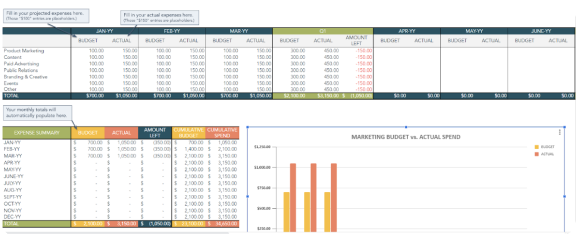

START-UP OR
ONGOING BUSINESS?
START-UP ORONGOING BUSINESS?
Statistics show that 82% of startups fail due to cash flow problems. This has been documented for many years and is one of the main reasons new businesses need help to succeed. It is essential to plan correctly to avoid cash flow issues that can undermine the growth and sustainability of the company.
Startups are one of the primary forms of entrepreneurship, allowing entrepreneurs and inventors to create their own companies and develop their ideas. To succeed, these businesses must take precautions to avoid cash flow issues. This means making projections to ensure the company has the resources to handle unexpected circumstances and stay afloat.
Of course, you wonder what budget you should allocate for your Marketing Plan.
To assign specific values, there are many factors, resources, tasks, and business needs that you must take into account so that the economic estimate is as realistic as possible.
Some initiatives are more accessible than others, and all have risks. However, with a good team and the necessary tools, you ensure an efficient budget investment, so your brand achieves your objectives and strategies.
Preparing a reasonable marketing budget is quite a challenge. Still, the important thing is to start by taking the time to reflect on your current situation and your objectives as a company. From here, and with the help of your marketing plan, identify the actions you want to carry out in the coming months and decide how much budget you should dedicate to them.
Determine start-up costs before determining a marketing budget.
Starting a business is a process that requires a significant commitment from the entrepreneur. It requires technical, financial, and management skills, as well as making strategic decisions. To ensure business success, it is essential to consider costs and budgets before its start-up. These must range from expenses necessary for equipment acquisition to those related to hiring human resources. The budget for marketing and advertising is also part of this stage. Its allocation largely depends on the initial capital available for the company, but it is always recommended not to commit more than 20% of it to these activities. In addition, before making a significant investment in digital marketing or advertising, it is essential to evaluate the target market and the risks inherent in each advertising strategy. Finally, it is always advisable to consult with trained professionals to obtain desired success.




Take advantage of our
budget guide!
Get excellent practical exercises to help you better organize your business.
Download today and start
enjoying its benefits
The percentage of a company’s marketing budget depends on many factors, such as the company’s size, marketing objectives, the amount projected for revenue and overhead, and others. However, there are some excellent guides to follow:
- B2B companies should spend 8 15% of their income on marketing
- B2C companies 9 -22%
- Startups: 12-25%
- B2B Products: 8.8%.
- B2B Services: 10.7%.
- B2C Products: 21.1%.
- B2C Services 9.9%.
WHAT TO BUDGET FOR?
When budgeting for marketing, there are several factors to consider. First, set clear short and long-term goals and objectives you want to achieve. This will help you find the best channels to reach your desired audience. Once you have these goals in mind, making a detailed plan on how you will spend the money to achieve them is essential. Secondly, set budget limits to ensure expenses do not spiral out of control. Setting proper budget control prevents unnecessary wastage and helps keep you on track with the campaign or project from start to finish. Finally, regularly measure your progress to assess whether changes are necessary or the budget requires adjusting. Staying on top of the campaign results will allow you to make informed decisions on your next move in terms of marketing.
Some of the things would be:
Online Presence
(Website/eCommerce)
Production (Content)
Social Presence
(Social Media)
Content Marketing
(Social/Blogs/Emails)
Events (Product
Launches/Webinars)
Traditional Advertising
(Print/Billboards)
Branding
(Signs/Business Cards)
Public Relations (Industry
Events/Media/Press Releases)
Technology
(Software/Hardware)
Unexpected Costs
Paid Search
Advertising

Practical exercise to plan your marketing budget

HOW TO CHECK IF THE
INVESTMENT IS WORTH IT
HOW TO CHECK IF THE INVESTMENT IS WORTH IT
To determine if a marketing investment is worth it, it is essential to perform a cost-benefit analysis. You must decide how much money you will spend to get the desired result. For example, if you need to increase your online presence, research which digital channels can offer the best return on investment. Set clear goals regarding the number of people you want to reach and the results you hope to achieve. Also, consider non-monetary factors; For example, are you looking to gain more reputation? Be sure to regularly measure the impact of your campaigns to ensure they are having the desired success.
Five steps to prepare your
marketing budget
Five steps to prepare your marketing budget
1. Know your buyer persona and audit your funnel
Marketing is a versatile and powerful tool, but it’s important to remember that it is also an investment. When planning your marketing budget, determine which objectives you want to achieve in the short and long term. Remember these objectives when choosing the best channels to reach your target audience. Set budget limits to avoid overspending and remaining within the envisioned project or campaign boundaries. Perform a cost-benefit analysis on each investment to ensure you receive the expected result without wasting resources. Regularly measuring progress will allow you to make informed decisions about what action to take next regarding marketing.
Let’s do this exercise together. Take some time to audit your project by analyzing the target audience you are addressing.
- How is your buyer persona? target audience
- Where do they usually consume information?
- Does this audience recognize your brand?
You will also need to know and understand their purchase funnel. Thus you can identify which channels or actions you must activate, maintain or eliminate from your marketing strategy. In other words, appreciate your purchase process as well.
2. Align your marketing plan with your business objectives and PRIORITIZE your activities
With your marketing plan in hand, review what actions you have decided to prioritize during the next quarter or year. Identify which of these actions imply a cost and of what type.
Although it is tempting to include many different actions, remember your objectives and the results each channel can offer when allocating your budget.
They must be SMART objectives: specific, measurable, achievable, relevant, and temporary (measurable over time).
S
Specific
Do: Set real numbers with real deadlines.
Don’t: Say, “I want more visitors
M
Measurable
Do: Make sure your goal is trackable
Don’t: Hide behind buzz like, “brand engagement,” or “social influence.”
A
Attainable
Do: Work towards a goal that is challenging, but possible.
Don’t: Try to take over the world in one night.
R
Realistic
Do: Be honest with yourself – you know what you and your team are capable of.
Don’t: Forget any hurdles you may have to overcome.
T
Time-bound
Do: Give yourself a deadline.
Don’t: Keep pushing towards a goal you might hit, “some day.”
CP TIP: Never base your marketing budget on what’s left after covering all other expenses.
Align your marketing plan with your business objectives to ensure every dollar spent contributes to the company’s success. Once the goal has been set, prioritize your activities for the highest return on investment possible. Thoroughly research the countries/regions/cities where market opportunities exist and determine if implementing a global or regional strategy would be more profitable. Utilize marketing tools and software to automate simple administrative tasks, allowing you to focus on strategic activities that positively affect financial results. Consider hiring a marketing consultant for professional advice or training on marketing strategies to improve your knowledge. It is essential to factor in budget, human resources, and other factors affecting the efficient implementation of any marketing plan.

Do you want to learn about
marketing analysis?
The following article explains how to obtain a competitive advantage, the impact of digital marketing in the current environment, and much more.
Do not miss it!
3. Take into account your operational costs
When rethinking your marketing strategy, you always have to consider operational costs. Ensure you clearly understand the data related to your spending to get the best possible insights and make intelligent decisions. Use tools like ROI measurement, price optimization, and value analysis to help you manage money. This will allow you to maximize results without going over budget.
Once you know the items in which you will invest and which are the highest priority for your company, assess whether you have the necessary people to carry out your action plan. Will you need to hire an internal team, internships, part-time or full-time?
Add these costs (even if they are approximate) to your budget for a more complete vision of the situation.
4. Include a contingency item
Tools like ROI measurement, price optimization, and value analysis help you manage your money wisely. It is necessary to clearly understand the data related to your expenses to make informed decisions. This will allow you to maximize results without going over budget. On the other hand, including a contingency element in your plan is essential to prepare for any unexpected problems and reduce the risk of delays or increased costs for the execution of the project.
If you want to achieve impressive objectives with your marketing strategy, always remember to consider these two premises: control investment and prevent unforeseen events.
When you plan a year, there is a chance that factors outside your company or internal changes may alter your initial plan.
Add an item for contingencies that allows you to cover possible eventualities: a media campaign to get more exposure for a new product or service, a campaign with a press agency to counteract a reputation crisis, an extra push to multiply the reach of a movement that is working incredibly well, essential training for the team…
Please note that this budget should be optional. If you consistently use your contingency budget, identify what you’re spending it on and adjust your cash games based on this information.
5. Review your results every month
Every month, review the results of your marketing strategy to determine if you are close to reaching your goals. This will help you evaluate the effectiveness of your actions and know if adjustments need to be made to steer them in the right direction. By measuring ROI, you’ll be able to identify which aspects of the plan are working best and which need to be tweaked or removed. On the other hand, you can compare the investment against the income generated by your campaigns and pricing models. This will give you a clear idea of the overall performance of your plan. If you want to improve the results every month, always remember to review the metrics related to your budget, goals, and investments.
In your budget document, update the investment you have been making every month.
If your budgeted expenses are very far from your actual situation at the end of the quarter or year, that’s okay. Take advantage of the learning this information gives you to define a better budget next time.
FUN FACT
A recent study shows that 72.2% of the current advertising budget is allocated to digital marketing. This figure reflects the rise of the web as an essential tool for promoting your brand and products. However, this means that you must find ways to optimize your investments for the best possible results within your budget. Tools such as ROI measurement, price optimization, and value analysis will help you achieve this. At the same time, it is essential to review the results every month to assess whether you are on track to achieving your desired goals. Set metrics related to your budget, investments and performance in order to monitor them and take corrective action when needed.
3 Examples of brands using budget planes
Starbucks has developed a budget strategy for leveraging its digital presence and social media. Starbucks’ digital media team consists primarily of two components: paid advertising and its organization. The brand thought carefully about the objectives it wanted to achieve with its budget to ensure that it had the right results. These goals include improving awareness, expanding and including an online community, and partnering with local influencers to build brand loyalty. In addition, the team also worked to understand customers’ behavior better online, so they could more efficiently segment and direct them to their ads. Starbucks used creative multimedia content to achieve greater reach without exceeding the budget with its online program. Thanks to this innovative approach, they could expand to new ones without the need for significant monetary outlays.
McDonald’s effectively uses its marketing budget to expand into new markets and promote its localized franchise. This strategy has significantly contributed to the global success of the brand. For example, in the last two years, a large advertising budget was dedicated to television and social media campaigns that reflected global trends. These campaigns helped position the brand name among modern content to attract a young audience. In addition, McDonald’s has also partnered with influencers and other companies to create commercial and promotional content aimed at the brand’s target segments. This practice allows it to expand its reach without exceeding its advertising budget, which contributes significantly to the success of its campaigns.
The “Share the Happiness” advertising campaign by Coca-Cola was a successful example of properly managing budgets. This campaign centered around a series of TV commercials that featured people from all walks of life sharing moments of happiness in their daily lives. The ads were visually appealing and emotionally powerful, portraying networks of joy that went beyond geographic boundaries and cultures. By leveraging this human connection, the brand was able to establish an emotional bond with its consumers and reach them with meaningful content. Additionally, profits generated from ad sales were used to create an educational fund for needy children. Thus, this successful strategy demonstrated the power of setting clear goals while optimizing financial decisions to make maximum impact with a minimal budget.



Take advantage of the opportunity to learn more about Market Analysis and improve your marketing skills.
Subscribe
to our YouTube channel today!
How to Launch Your Business
A Four Part Series How to Structure Your Business From Scratch


Creative Marketing Strategy

Outline strategy & define budget
Get On Trend
Marketing Tips
Don’t fall behind! Get the latest marketing trends and tips sent straight to your inbox.







